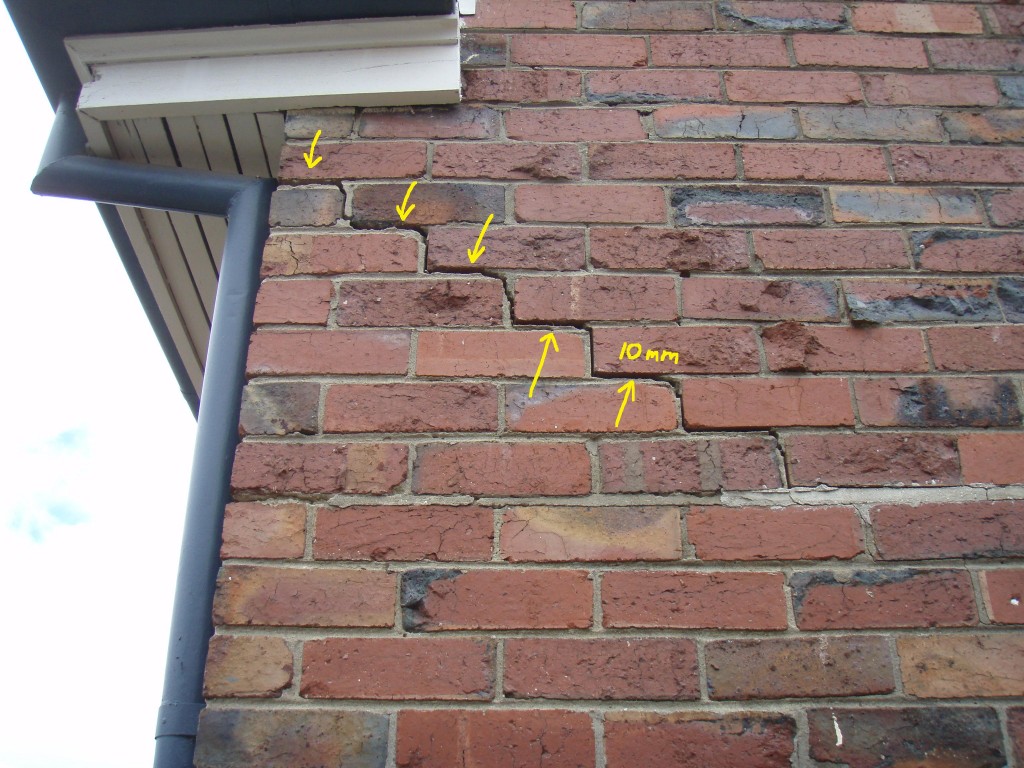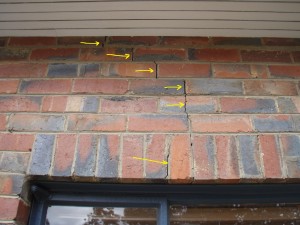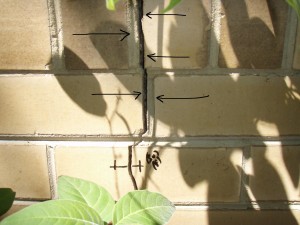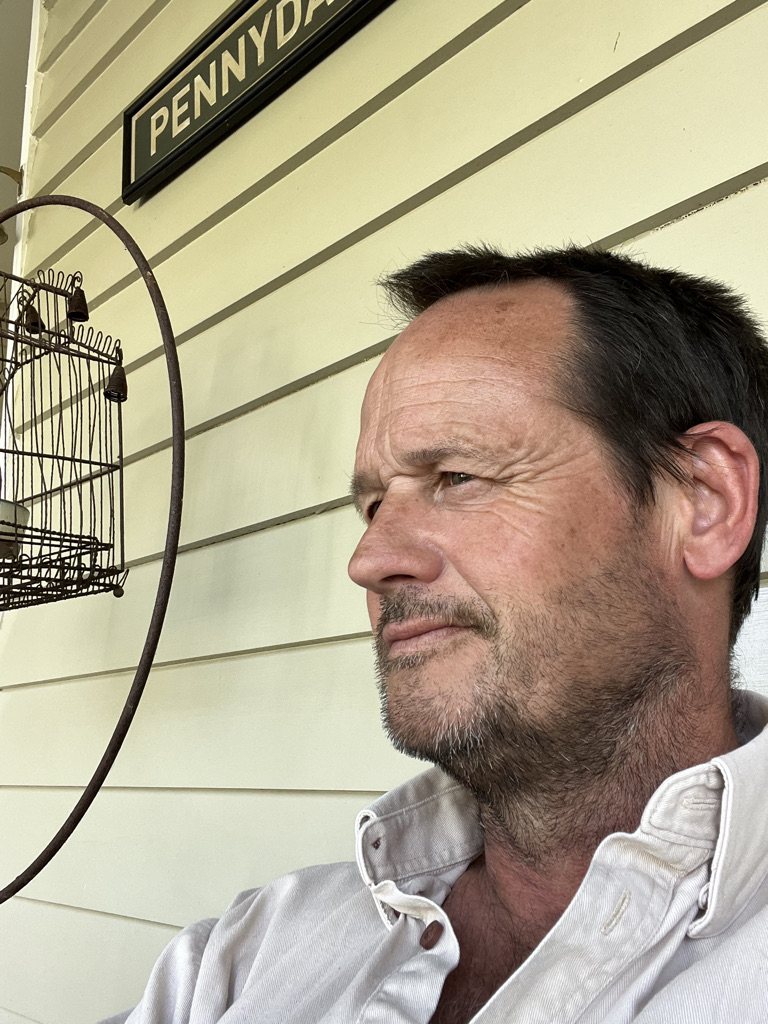
Since 2004, Mr Inspector has been conducting Building Inspections Melbourne wide assisting home buyers with the condition of their potential home.
Introduction
Having carried out thousands of building inspections around Melbourne we can conclude that brick masonry cracking is quite common in Victorian homes today.
Brick masonry cracking is categorized (Category 1, 2, 3 and 4) depending on the size of the cracking, width of the crack, number of cracks and the location of the crack. This then helps Mr Inspector determine what you need to do in relation to repair, prevention or cure.
Certain cracks may require assessing by a structural engineer. This can cost anywhere from $500 to $1500 for an assessment by a structural engineer.
Cracking in masonry can generally be attributed to a number of causes. They can range from trees being too close to homes and the tree roots sucking excessive moisture from the soil, expansive soils like clay, earth tremors, heavy traffic usage, poor preparation and design of footings, poor drainage, broken water pipes, storm water not connected and the like.
Cracking and Causes
The majority of excessive brick cracking, either through brick course mortar of through the masonry bricks themselves can in most cases be blamed on movement in the footings and foundations of the structure. Lower wall cracking is a good indication of unstable footings and foundations whereas upper cracking can be contributed to expansion and shrinkage or deterioration of a steel lintel. Below is cracking adjacent above a rusting window lintel which is more than likely the cause of the cracking (as apposed to unstable footings.) You can also see a slight bow in the steel lintel.

There are various types of foundation failure or damage. These include foundation cracks, masonry foundation crack patterns, moving, leaning, bulging, or bowing of building foundation walls.
Causes of masonry cracking include:
- Constructed on fill
- Constructed over or close to a ravine
- Area geology e.g. Sink holes, Lakes and Streams
- Soil classification e.g. Land fill, expansive soils like clay.
- Foundation leaks and leaks from plumbing and sewerage.
- Poor design of footings for soil classification.
- Earth tremors.
- Drought followed by heavy prolonged rainfall.
Clay and land fill soils are normally the worst for any movement in the homes foundations.
Elwood in Victoria is a good example of land fill on swamp and there are numerous homes in Elwood that have external and internal wall cracking due to unstable soils.
It is alleged that the best soils to build upon are rock followed by sand. Rock sub soils are stable and sand has very good drainage.

Diagnosis and rectification
In today’s environment you should not see homes built in the last 5 years with significant masonry cracking which has been caused by unstable footings and foundations or movement within same. Soils are tested and classed and appropriate steps and design techniques are taken to refine any possible movement in a home.
Older homes with cracking need to be diagnosed as to the cause and then possible rectification method. It is said that cracking widths and the number of cracks in the mortar or the brick along with the location of the actual cracking can indicate causes. Lower brick course cracking on corner and straight through a brick as apposed to the mortar indicates movement in the foundations and footings of a home.
The width of the cracking indicates the seriousness of the crack and need for rectification. A guide set out by the Victorian Building commission indicates that hairline to 1 mm width cracks are not an issue. Cracks less than 5 mm can normally be filled or re-pointed. Cracks with widths between 5 to 20 mm and greater will need appropriate classification and rectification works which can include re-pointing, removing of bricks to the more serious and expensive works of under pinning. Under pinning involves digging under the footings and foundations and bracing them and then pouring concrete under same to stabilise. Other newer methods are resin injections to lift and level a home.
What you can do
Cracking in older homes in areas with poor subsoils or expansive sub soils is very costly to remedy. Underpinning can cost between $5000 and $25,000 depending on how many sections will require actual underpinning. Greater emphasis is put on stable footings and foundations now as apposed to the 70’s and 80’s.
I would recommend a structural engineer or a house inspection service check out your home for these major concerns prior to buying. Avoid asking a re-stumping or under pinning company for answers, get the home inspected by a qualified building inspector or structural engineer first.
If you are experiencing cracking at you home there a few things you should consider. It is important to have all cracking accurately diagnosed by a building inspector.
- Record the date you 1st saw the cracks appear. Take a few photographs of them with a ruler indicating the size. This can be important in determining the cause. For example there may have been a recent earth tremor you didn’t know about that caused it.
- Check you down pipes are connected. Excess water can cause differential settlement.
- Have a look and see if there has been a large jump in water usage – can indicate a plumbing leak – excess water pouring into your homes footings can cause settlement cracking.
- Inspect the sub floor of the home for dampness. A plumber may be required to assess and sub floor ventilation improved.
I Hoe this has assisted you and if you have any queries, please contact Mr Inspector.

Peter has a Diploma of Building Surveying which makes him one of the few in Melbourne who are Qualified to carry out building inspections as per the Building Act 1993. He is also qualified in Timber Pest Inspections (Cert 3), Pool Barrier Inspection (Certificate 11077454) and Non-Friable Asbestos Awareness and removal.

